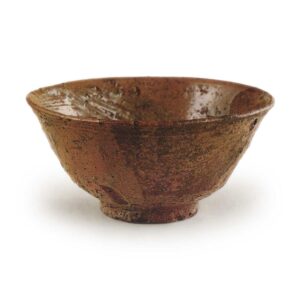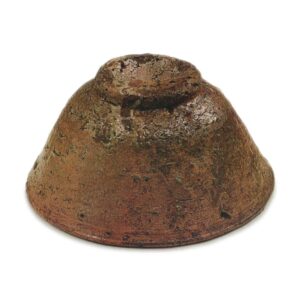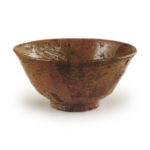

Height: 6.9 – 7.1 cm
Diameter: 13.9 – 14.1 cm
Outer diameter of foot ring: 5.7 cm
Height of foot ring: 0.9 – 1.0 cm
Like the Chigusa Iraho of the Hirase family, it is said to have come from the Chigusa family, but the story that both bowls were kept in the Chigusa family is somewhat lacking in credibility, and the circumstances surrounding them are unclear.
The shape and glaze of the tea bowl is almost identical to the one that came from the Hirase family, and it is thought that they were probably made at the same time by the same potter, but of course there are some slight differences in shape and glaze.
The glaze applied to the one side of the bowl is a burnt brown ira-ho glaze, which covers about one third of the bowl, and the other two thirds are covered in a thick, bluish-green iro-yu glaze. In addition, there is a particularly thick layer of well glaze on the outside, from the rim to the foot, which becomes even bluer towards the foot, creating a beautiful scene, and on another side, there are two distinct finger marks on the foot, which also create a beautiful scene. The well-glazed interior of the bowl is clearly brushed twice, with one brush stroke running horizontally along the rim and the other brush stroke running diagonally from the rim to the interior. The well-glaze on the brushed areas is also strongly blue, and the craquelure is also coarse. The burnt yellow glaze of the brown glaze is also beautiful.
From the foot to the shoulder, the kaaragi pattern appears, and the rich variety of scenery in this part is truly exquisite. The marks in the center of the inside are not clear, but you can see a few small iron flecks scattered in the well glaze on the side. The inside of the foot ring is slightly shallower than the HIRASE family tea bowl, and the rim of the HIRASE family tea bowl is slightly deeper.
The mouth of the HIGUCHI family tea bowl is almost the same as the HIRASE family tea bowl, and the thin part of the glaze on this tea bowl also has a distinct lathe mark. And the promised bevel is also small and in one place.
The foot ring is slightly thick, and there are five marks on it, two of which are connected. There is a stone chip mark inside the foot ring, and there is also a crack running through the center of the body. There is also a stone chip mark on the outside of the rim, and there are also many small pebble grains visible on the glaze.
The two characters “Chigusa” on the front of the inner box lid are said to be the handwriting of Hosokawa Sansai, but if he wrote them when the tea bowl was in the Chigusa family, it would have been before 1645 (when he was 83 years old), and it is thought that it was during the time of the first Chigusa family head, who was a talented individual. In addition, the “Collection of Famous Instruments from Various Families” states, “Possessed by Chikusa Iraho, Chikusa Saisho, Hosokawa Sansai, etc.,” and it is thought that it passed from the Chikusa family to Hosokawa Sansai , but this is probably because the author of the box inscription is said to be Sansai, so it is thought that Sansai owned it, but it is not clear whether or not Sansai actually owned it. If Sansai did own it, then Chikusa Aritomo must have owned it in his youth.
Later, it was passed on to Doi Oi no Kami and Matsudaira Kai no Kami, and around the Kyowa era, it became the property of Matsudaira Fumai, through the mediation of the Edo-based tool dealer Sokichi and Kiya Goro. The price was 500 ryou (some records say it was 550 ryou).
It was added to the section on famous tea bowls in the “Unshu Meibutsu Ki” (Famous Things of Unshu), and since then it has been passed down in the Matsudaira family, but in 1932 it was given to Nakano Chutaro of Niigata, and after the Pacific War it left the family and came into the possession of the current owner.
The inscription on the lid of the inner box, “Chigusa”, is by Hosokawa Sansai, and the gold-painted characters on the inner box, “Iraho Chigusa”, are said to have been written by Kinokuniya Bunzaemon.








